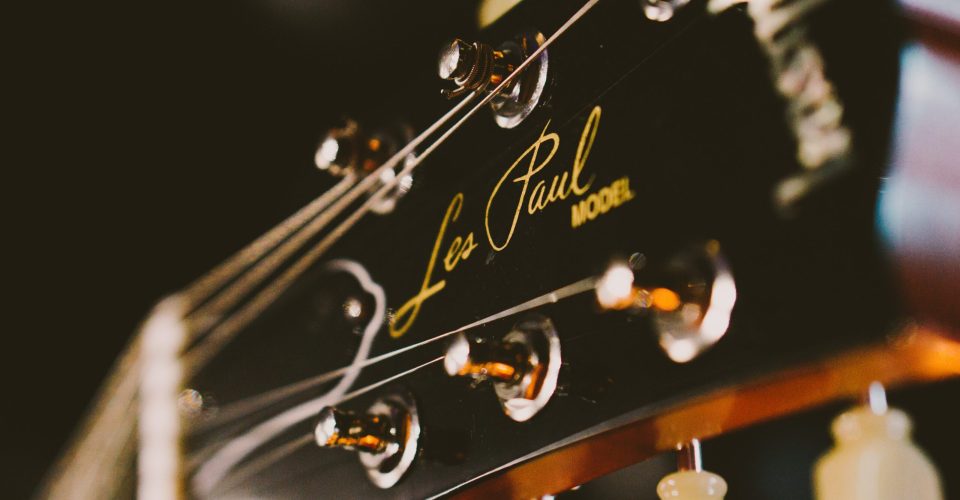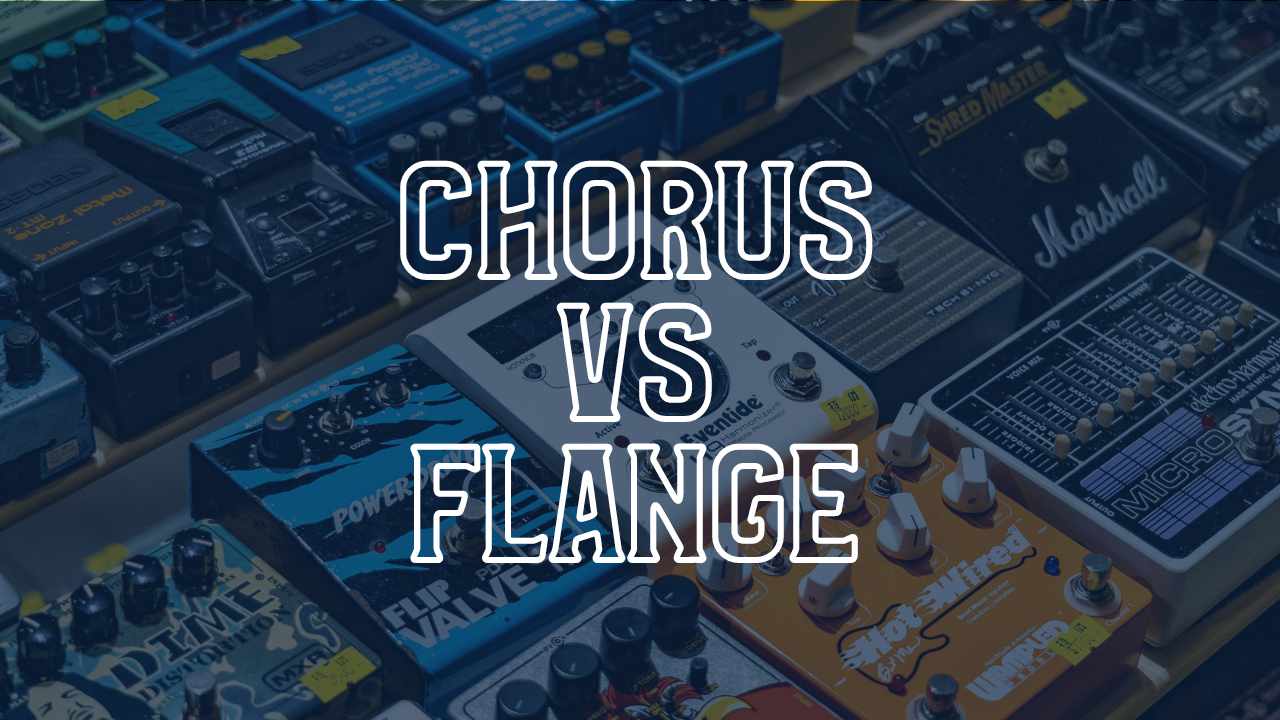The humble guitar nut: the source of countless tuning frustrations and the bane of Bigsby players. The nut is yet another one of the small parts of your guitar that can have a surprisingly big impact on your tone, playability, and tuning. Even though things like guitar strings, scale length, and pickups are a bit more important in the grand scheme, the nut is still a part you shouldn’t overlook.
So today, we cover why the nut matters, what options are available, and what the pros and cons of each option are. Whether you’re a beginner with a plastic nut or a pro who swears by ebony, this article should help learn more about nuts and which one is best for you.
Why The Nut Matters
To start, the nut is that little piece at the headstock of your guitar that the strings slot into. The nut keeps your strings in position, and it impacts the tone of every open string. It’s important to note here that the nut only affects the tone of open strings. Once you fret anywhere on the neck, you take the nut out of the equation since the string is vibrating between that fret and the bridge.
Outside of its impact on the tone of open strings, the nut also plays an important role in tuning. Your strings will move across the nut as you tune and play, especially if you have a vibrato or tremolo of any kind. A slick nut can allow the strings to move more freely, decreasing tuning issues, while other nuts can make that more difficult and make staying in tune a pain.
Depending on your guitar and style of play, the nut can be hugely important. For example, Floyd Rose users can run into incredibly annoying tuning problems if they’re not using a nut that makes string movement easier (such as graphite). Changing to the nut that best suits your style and guitar can have a huge impact on your tone and tuning.

Different Nut Materials
Moving past the basics of nuts, let’s talk about the different nut materials available. There are a lot of different options nowadays, so let’s take a look at each one and see where they succeed and where they fall short.
Plastic
Plastic nuts are the most common, but there are really two different types of plastic nuts. There are the cheap plastic nuts that come on low end guitars, and there are high end plastic nuts such as TUSQ that are used on higher end guitars.
As you probably already guessed, the cheap plastic nuts aren’t great. Tonally, they’re considered the worst option out there. They’re also very brittle, meaning they can break easily. For people gigging or putting a lot of pressure on their nuts (like via a tremolo or vibrato), they aren’t a great choice. On top of that, they aren’t great when it comes to tuning either. Cheap plastic nuts aren’t the worst thing ever, but you probably should replace yours if you can afford to.
The high end plastic nuts are an entirely different story however. Nuts like TUSQ are made from modern, high end plastics and are designed to mimic bone. These nuts provide better tone than plastic nuts, are more durable, and are self-lubricating for better tuning consistency. They are also very durable thanks to the materials they are made out of.
As expected, they are more expensive than cheap plastic nuts, but they’re worth it. High end plastic nuts may not look as cool or sound as interesting as brass or ivory, but they are a great option commonly used by the pros.
Bone
Next up is bone, which is considered by many to be the best nut material out there. These are commonly seen on vintage Martins, Gibsons, and Fenders—and for good reason. Bone nuts are very hard, durable, and provide a great, bright tone. They are also self-lubricating for better tuning stability. Another plus is that they are relatively easy to work with, saving you (or your tech) some time when it comes to shaping, angling, and slotting.
However, there’s always a downside. The biggest downside of bone nuts is that bone is an inherently inconsistent material. There can be soft spots, creating issues with tone, stability, and ease of modification if you get a nut with a soft spot. You may have to go through multiple nuts to find a perfect one.
All that said, bone nuts are still coveted by many for a reason. It’s a durable material that provides a great tone, while also giving good tuning stability. If you have time and money to deal with the possible inconsistencies of bone nuts, they are a great option.
Fossil Ivory
Fossil ivory is another natural material used for nuts. To clarify, ivory is still illegal. Fossilized ivory on the other hand is legal and is ethically sourced from wooly mammoth and walrus tusks. As expected, fossilized ivory nuts are harder to come by and more expensive than most other options.
As a nut, fossilized ivory is very similar to bone. They are a little bit harder than bone, so they’re very durable. Their big advantage is tone though, as they provide a very pronounced tone that many swear by. It’s still similar to bone, but with a bit more clarity and distinction.
And even though it’s not important, fossilized ivory nuts have a cool factor like none other. They look great, and they come from a wooly mammoth (or walrus)! A fossilized ivory nut can be a great conversation starter with fellow guitar nerds.
There are two big downsides to these nuts though—cost and ease of use. Because fossilized ivory is much more limited material, the price is naturally higher. And since they’re harder than bone, they can be very tough to work with. That means spending more money at the shop or more time in your own workshop to get one installed.
Ebony
Ebony is a classic nut material, though it is less common now than in the past. Many classic Gibson jazz boxes came with ebony nuts, and many jazz players still stand by them to this day even though they are cheaper than bone or fossilized ivory.
Ebony nuts provide a warmer tone than a lot of other nuts, which is why jazz players tend to like them so much.They also just look great. They have a nice, sleek, black look that you can only really get with an ebony nut.
The only real downside of ebony nuts is durability. Ebony is much softer than bone, fossilized ivory, or high end plastics. They can wear quickly, so you may find yourself replacing them more often. However, they are cheaper, so it may balance out in the end.
Graphite
Graphite nuts are a more modern thing, mainly designed to improve tuning issues—particularly on guitars with tremolos or vibratos. An old trick is to use a pencil to add graphite to your nut slots so strings can move easier. Making the whole nut graphite makes it even easier for string to move. In terms of tuning stability, nothing can beat the graphite nut.
There are downsides though. They don’t provide the tonal benefits that ebony, fossilized ivory, and bone do. They also only come in black, which limits your aesthetics options. That said, if you are a heavy vibrato or tremolo user, graphite is the way to go.
Metals
Last but not least are the metal nuts. Metal nuts were very popular in the 70s, but they have since become much less common. Typically, metal nuts are either brass or steel, though aluminum has been used as well (such as one the Peavey T-Series).
These nuts provide a very specific and unique tone that isn’t for everyone, but lots of people love them. They’re very bright and clear with glistening harmonics. A lot of country players still use them, and Jerry Garcia famously was a big fan of brass hardware (including the nut).
One major upside of metal nuts is durability. Metal nuts can last decades upon decades without needing to be replaced. Metal nuts on guitars from the 70s are still going strong to this day, proving their durability and longevity.
Unsurprisingly though, metal nuts can be incredibly difficult to work with. They take a lot longer to shape, which also means they’re more expensive to have installed. And as mentioned above, the tone definitely is not for everyone. We recommend trying a metal nut in person before committing to one.

What Nut’s For You?
No matter what kind of guitarist you are, you should take the time to figure out what nut works best for you. If you’re a jazz player, maybe it’s ebony. If you’re a shredder with a Floyd Rose, graphite is a safe bet.
Either way, think about your playing style and which nut would get the best results for you. As always, don’t be afraid to head to the guitar store and try out some different options. And when you finally pick the perfect nut, don’t forget to string up your guitar with some Stringjoy strings!







